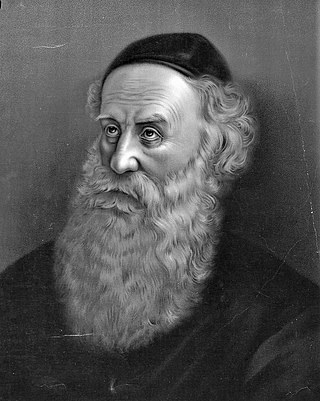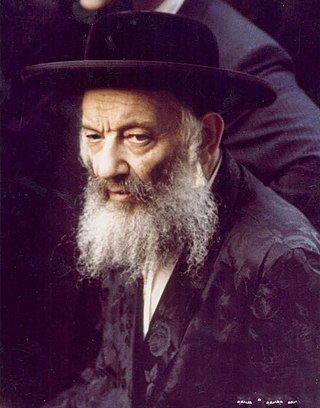Related Research Articles
Amoraim refers to Jewish scholars of the period from about 200 to 500 CE, who "said" or "told over" the teachings of the Oral Torah. They were primarily located in Babylonia and the Land of Israel. Their legal discussions and debates were eventually codified in the Gemara. The Amoraim followed the Tannaim in the sequence of ancient Jewish scholars. The Tannaim were direct transmitters of uncodified oral tradition; the Amoraim expounded upon and clarified the oral law after its initial codification.

A Rebbe or Admor is the spiritual leader in the Hasidic movement, and the personalities of its dynasties. The titles of Rebbe and Admor, which used to be a general honor title even before the beginning of the movement, became, over time, almost exclusively identified with its Tzadikim.

Shneur Zalman of Liadi was a rabbi and the founder and first Rebbe of Chabad, a branch of Hasidic Judaism. He wrote many works, and is best known for Shulchan Aruch HaRav, Tanya, and his Siddur Torah Or compiled according to the Nusach Ari.
Eleazar of Worms, or Eleazar ben Judah ben Kalonymus, also sometimes known today as Eleazar Rokeach from the title of his Book of the Perfumer —where the numerical value of "Perfumer" is equal to Eleazar, was a leading Talmudist and Kabbalist, and the last major member of the Hasidei Ashkenaz, a group of German Jewish pietists.
Judah ben Samuel of Regensburg, also called Yehuda HeHasid or 'Judah the Pious' in Hebrew, was a leader of the Chassidei Ashkenaz, a movement of Jewish mysticism in Germany considered different from the 18th-century Hasidic movement founded by the Baal Shem Tov.
Chaim of Volozhin was a rabbi, Talmudist, and ethicist. Popularly known as "Reb Chaim Volozhiner" or simply as "Reb Chaim", he was born in Volozhin when it was a part of the Polish–Lithuanian Commonwealth. He died there while it was under the control of the Russian Empire.
The Hasidim of Ashkenaz were a Jewish mystical, ascetic movement in the German Rhineland during the 12th and 13th centuries.

The Mekhilta of Rabbi Shimon ben Yochai is midrash halakha on Book of Exodus from the school of Rabbi Akiva attributed to Shimon bar Yochai. No midrash of this name is mentioned in Talmudic literature, but Nachmanides (d.1270) refers to one which he calls either Mekhilta de-Rabbi Shimon ben Yochai, Mekhilta Achǝrita de-Rabbi Shimon, or simply Mekhilta Acheret. Todros ben Joseph Abulafia (d.1285) also refers to Mekhilta de-Rabbi Shimon ben Yochai.
Kalonymos or Kalonymus is a prominent Jewish family who lived in Italy, mostly in Lucca and in Rome, which, after the settlement at Mainz and Speyer of several of its members, took during many generations a leading part in the development of Jewish learning in Germany. The family is according to many considered the foundation of Hachmei Provence and the Ashkenazi Hasidim.
Mar ben R. Huna ; was one of the first Gaons, and head of the Sura Academy in Babylon at the end of the rule of the Sassanid Empire.
Koidanov is a Hasidic dynasty originating from the city of Dzyarzhynsk (Koidanov), Belarus, where it was founded by Rabbi Shlomo Chaim Perlow (1797–1862) in 1833. Koidanov is a branch of both Lechovitch Hasidism and Karlin-Stolin Hasidism as Rabbi Shlomo Chaim Perlow was the paternal grandson of Rabbi Mordechai of Lechovitch and the maternal grandson of Rabbi Asher of Stolin. Koidanov was the smallest of the three Lithuanian Hasidic dynasties, with most of its Hasidim being murdered in the Holocaust. The dynasty was re-established after the war in Tel Aviv, then moved to Bnei Brak, where the majority of the dynasty is located, but there are Chassidim located around the world.

Yosef Greenwald was the second Rebbe of the Pupa Hasidic dynasty. Before World War II he was a rabbi and rosh yeshiva in Pápa, Hungary.
Rav Mari ben Rav Dimi was the second Dean of Pumbedita Academy, succeeding Hanan of Iskiya. During Babylonian persecution of Pumbeditan Jewry, several notable scholars left to establish a Yeshiva academy in Firuz Shapur. Rav Mari served as the dean of this Yeshiva until the death of Hanan of Iskiya in 609, after which he was elected successor in the gaonate.
Sefer ha-Asuppot is the name of a compilation of medieval German Jewish halakha and minhagim, the manuscript of which is privately held by David H. Feinberg of New York. The work includes a large number of teachings, minhagim, descriptions of popular costumes, halachic rulings, and collected stories from numerous authors, displaying the ordinary life of Rhineland Jews in during the twelfth and thirteenth centuries. The manuscript is endowed with vowel signs almost throughout, which makes it the only non-liturgical and non-Biblical text of its kind, and the vowels follow the Spanish pronunciation. The manuscript is the work of several scribes, containing multiple hands and multiple inks. One scribe was probably named Meir.
Moses ben Eliezer Cohen was a Jewish writer and moralist who lived in Germany, probably at Coblenz, in the second half of the 15th century.
Rabbi Samson ben Yosef the Elder of Falaise was one of the Tosafot. His brother-in-law was Rabbeinu Tam, who held him in high esteem.
Rabbi Meshullam ben Kalonymus, was born in Lucca, Italy, or in Mainz, Germany. He was a posek of the Gaonic period, a commentator on the Mishnah and a Paytan.
Rabbi Avraham ben Solomon,, also known as Abraham Ragoler was the brother of Elijah, the Vilna Gaon. He was a Kabbalist and darshan (preacher), and author of the book Ma'alot HaTorah.
References
- ↑ Teshuvot Maharshal 29
- ↑ "כנסת ישראל - פין, שמואל יוסף בן יצחק איזיק, 1818-1890 (page 4 of 702)". www.hebrewbooks.org. Retrieved 2024-03-28.
- ↑ "אוצר הגדולים אלופי יעקב - חלק ב - הכהן, נפתלי יעקב (page 18 of 286)". www.hebrewbooks.org. Retrieved 2024-03-28.
- ↑ "ABIN - JewishEncyclopedia.com". jewishencyclopedia.com. Retrieved 2024-03-28.
- ↑ "אוצר החכמה". tablet.otzar.org. Retrieved 2024-03-28.